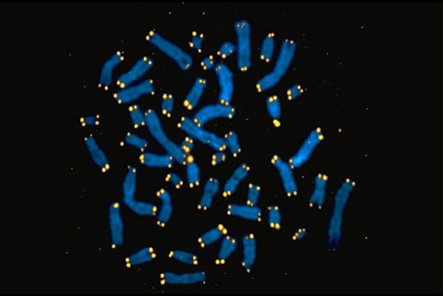Answers to Aging from the Amish
Is your time up when your telomeres wind down?
Aging and life span might be influenced by how quickly DNA is whittled away from the tips of chromosomes within cells.
Telomeres, pronounced TEE-low-meres, are DNA caps. They protect genes at the tips of chromosomes - all 23 pairs that reside in the nucleus of each of our trillions of cells. They are kind of like the tips that keep your shoelaces from unraveling.
A handful of studies indicate that telomeres are shorter in the immune cells of older people in comparison with the young. Now, a research team led by UCSF's Wen-Chi Hsueh, MPH, PhD, suggests that telomere length might be associated with life span itself. Hsueh and colleagues published their very preliminary findings in the July 17 issue of the Proceedings of the National Academy of Sciences (PNAS).
The PNAS study co-authors believe they are the first to report an association between telomere length and life span. But the finding needs to be confirmed, Hsueh says, as more data on life span become available. Only 35 study participants have died so far.
Cellular Life Span, Human Life Span
In many organs that have been studied, telomeres get shorter with successive cell division. If telomeres become too short, a cell can no longer divide. Instead, it is likely to become old and die. The inability of cells to regenerate due to telomere shortening is believed by some researchers to play a role in the aging of the entire organism. There is an enzyme - called telomerase - that replenishes lost telomere length. However, in many tissues, it is inactive or only slightly active.
In recent years, scientists have developed exacting procedures to more quickly measure telomere length in the lab. They most often measure telomere length in immune cells obtained from blood draws.
As with many already established health indicators, scientists are discovering that telomere length appears to be influenced by both nature and nurture - or lack of nurture. Researchers at UCSF, including psychologist Elissa Epel, PhD, and leading telomere expert Elizabeth Blackburn, PhD, already have identified an association between chronic emotional stress in women and telomere shortening.
But Hsueh, a genetic epidemiologist, investigates hereditary influences that affect aging. Hsueh and her collaborators, in their ongoing study of the Pennsylvania Dutch - 356 Amish men and 551 Amish women - found that a significant proportion of variation in telomere length could be explained by genetic factors.
Dads' Hereditary Influence Appears Stronger
The researchers discovered that average telomere length in fathers - but not mothers - was related to telomere length in children. Moreover, the researchers found an association between daughters' telomere length and how long their fathers lived. This suggests that life span and telomere length may share some genetic determinants.
"It's very rare to observe such a paternal inheritance phenomenon for complex traits, so I was very surprised," Hsueh says.
The likely explanation is a biological phenomenon known as imprinting, Hsueh says. In imprinting, the activity of certain genes depends on whether they were passed down through one's mother or one's father. The maternal gene copies are not active. The exact mechanism by which imprinting might affect the inheritance of telomere length remains mysterious, Hsueh says.
Why Study the Amish?
Hsueh began studying diabetes in the Old Order Amish in Lancaster County, Pennsylvania, 12 years ago, when she was a graduate student at Johns Hopkins University, working with Alan Shuldiner, MD, a co-author on the PNAS paper. Later, after she had joined the UCSF faculty, Hsueh became interested in the epidemiology of telomeres and aging when Richard Cawthon, MD, PhD, of the University of Utah - also a collaborator on the most recent study - came to San Francisco to speak at a meeting on aging research.
Humans are quite diverse genetically and behaviorally. That makes work difficult for scientists who look for genes that help determine human traits and fates. Fortunately for these scientists, there are still some small populations on the planet with strong cultural traditions that have kept largely to themselves.
"We know that there are many genes and many environmental risk factors," Hsueh says. "To minimize the complexity of searching for genes, we want to study a population with a small gene pool, where there are likely to be fewer disease genes. That should enhance our ability to find them."
The Amish fit the bill. They have a small number of ancestors - about 200 Amish families came to the United States from Europe about 14 generations ago, during the early to mid-1700s. Now, there are about 30,000 Old Order Amish living in Lancaster County. They do not marry outsiders. As a result, they have little variability in their genes - a small gene pool. That reduces the complexity of finding genetic variants that may be associated with particular traits or diseases within the population.
There also is little variation in lifestyle and environment to complicate the study of genetic influences on aging, Hsueh notes. Amish women do not smoke or drink, and those behaviors also are very rare among Amish men. The Amish eat together in large groups and have similar schedules.
Chicken or Egg?
Hsueh suggests that telomere length may be one of the factors that influence biological aging, which itself remains a poorly defined measure, but nonetheless is distinct from chronological aging. Hsueh and colleagues also are keeping tabs on measures commonly associated with health in aging populations. These measures include bone mineral density and lung function, which tend to decline with age, and blood pressure and blood glucose, which tend to increase with age.
Hsueh does not rule out the possibility that telomere length is just a side effect or marker of other biological processes that may more directly affect health as we age.
The cause-and-effect relationship between telomere length and aging and life span is not yet clear, Hsueh says. It should become clearer, she says, as the study of the Amish and other populations continues. "Telomere shortening could be a consequence of aging, or telomere shortening could affect the rate of aging. As we study more data collected over a long period of time, hopefully we will know better."
In her search for genes that influence aging, Hsueh also wants to find genes that might influence whether telomeres are long or short, and how quickly they grow shorter with age. Hsueh also is careful to point out that a set of genes that influences healthy aging may not be identical to one that helps determine how long we might ultimately live. "Some genetic factors may help people live longer, and some genetic factors - not necessarily the same ones - may help people live healthier," she says.
Hsueh photo by Susan Merrell
Related Links:
The Long and the Short of It
Economist, July 12, 2007
For the New York Times, UCSF's Blackburn Answers Questions About Stress and Aging
UCSF Today, July 3, 2007 Blackburn Explains Award-Winning Research
UCSF Today, March 16, 2005 Study Suggests Link Between Psychological Stress and Cell Aging UCSF Today, November 30, 2004
 |
Wen-Chi Hsueh |
 |
DNA caps called telomeres (yellow) protect gene-bearing chromosomes (blue). Average telomere length varies among individuals. Telomere length may decrease with age and may be associated with health status or lifespan. Image courtesy of Peter M. Lansdorp, BC Cancer Research Centre, Vancouver, Canada |
|
Telomere Length Is Paternally Inherited and Is Associated with Parental Lifespan
Omer T. Njajou, Richard M. Cawthon, Coleen M. Damcott, Shih-Hsuan Wu, Sandy Ott, Michael J. Garant, Elizabeth H. Blackburn, Braxton D. Mitchell, Alan R. Shuldiner, and Wen-Chi Hsueh
Proceedings of the National Academies of Science 2007;104:12135-12139
Abstract |
Full Text | Full
Text (PDF) |
UCSF Today, July 3, 2007 Blackburn Explains Award-Winning Research
UCSF Today, March 16, 2005 Study Suggests Link Between Psychological Stress and Cell Aging UCSF Today, November 30, 2004